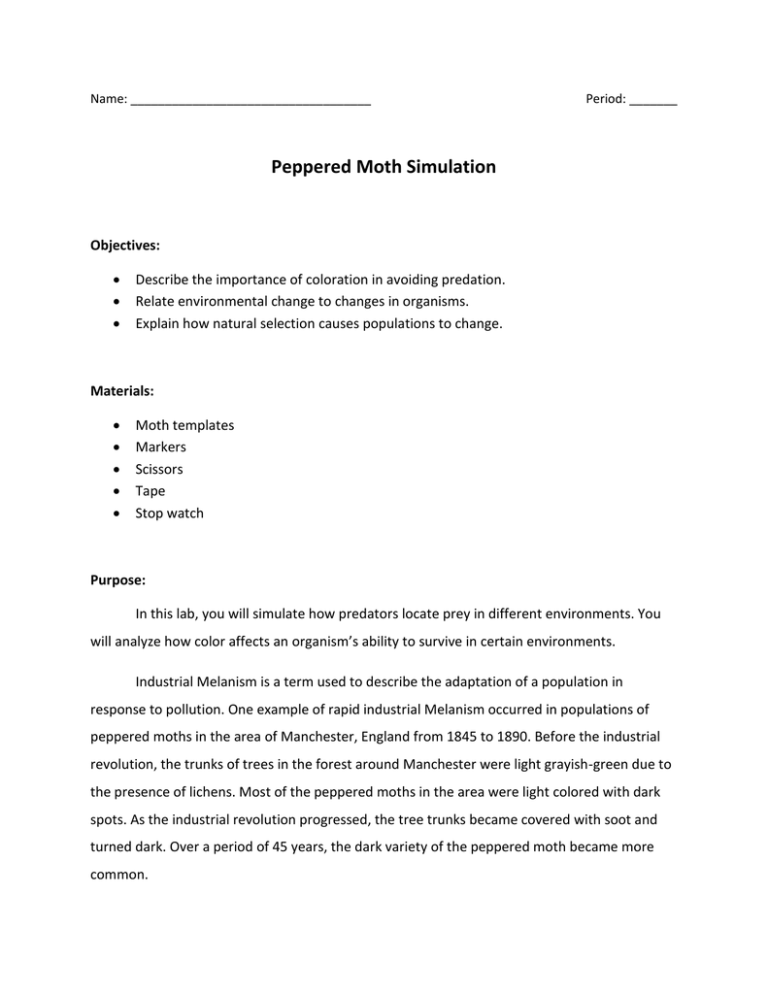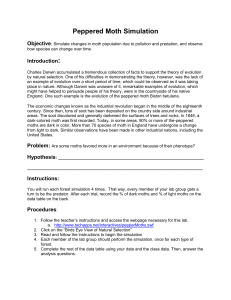Evolution Notes Peppered Moth Lab
advertisement

Name: ___________________________________ Period: _______ Peppered Moth Simulation Objectives: Describe the importance of coloration in avoiding predation. Relate environmental change to changes in organisms. Explain how natural selection causes populations to change. Materials: Moth templates Markers Scissors Tape Stop watch Purpose: In this lab, you will simulate how predators locate prey in different environments. You will analyze how color affects an organism’s ability to survive in certain environments. Industrial Melanism is a term used to describe the adaptation of a population in response to pollution. One example of rapid industrial Melanism occurred in populations of peppered moths in the area of Manchester, England from 1845 to 1890. Before the industrial revolution, the trunks of trees in the forest around Manchester were light grayish-green due to the presence of lichens. Most of the peppered moths in the area were light colored with dark spots. As the industrial revolution progressed, the tree trunks became covered with soot and turned dark. Over a period of 45 years, the dark variety of the peppered moth became more common. Procedure: 1.) Using different sized moth cutouts, color in as many moths as you wish (make sure you know how many you have made). Look around the room and color some moths with the intention of camouflaging and others that will not be camouflaged. 2.) Once you color moths that will blend in and stick out, tape them to the walls and other objects in the room that are in plain view of the taped off box on the floor. If you aren’t sure, test it out by going to the box and making sure you can see the entire moth from this spot. 3.) Everyone tapes their moths around the room, camouflaging some and leaving others “sticking out.” 4.) Tally up the TOTAL number of moths in the room. 5.) In the hall, tell the first official “predator” that he/she will have 1 minute to find as many moths (prey) as he/she can. Record the number of moths found that were camouflaged and the number of moths found that were not. Repeat with 3 different moth finders. Record all data in the chart below. Data: Total number of moths in the room: ______________ Trials 1 2 3 Average Number found camouflaged Number found not camouflaged Analysis: 1.) What did this experiment show about how prey are selected by predators? 2.) Which group of moths was selected most often by the predators, the camouflaged moths or the moths that weren’t camouflaged? Why do you think this happened? 3.) How does this simulation model natural selection? 4.) Examine the table and construct a graph. Plot the years of the study on the X-axis and the number of moths captured on the Y-axis. You should have 2 lines on your graph: one for light-colored moths, and one for dark-colored moths. Title: ______________________________________________________________ Year # of light moths captured 2 537 3 484 4 392 5 246 6 225 7 193 8 147 9 84 10 56 5.) Explain in your own words what the graph is showing. 6.) Describe a situation when this type of selection might occur. # dark moths captured 112 198 210 281 337 412 503 550 599









